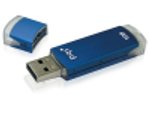thumb drive
 a.k.a. flash drive, junk drive, jump drive, travel drive
a.k.a. flash drive, junk drive, jump drive, travel drive A small, portable memory storage device about the size of a thumb, it has replaced floppy disks, ZIP Disks and CD-ROMs. Thumb drives (also known as flash drives, jump drives, and travel drives) fit into any USB port on a computer and are often seen hanging on key chains or lanyards around the necks of computer users everywhere.
A thumb drive is re-writeable and unlike RAM, it holds its memory without a power supply. They will also "hot swap," which means a user can plug the drive into a computer and will not have to restart it to access the thumb drive.
Thumb drives are considered very stable memory storage devices. IBM came out with thumb drives in 1998, as a solution for replacing the less stable floppy disks but a Singapore firm has since won the patent. Note: they are not compatible with Windows 98 and earlier operating systems and they also pose security threats since they are easily concealed. For instance, users could copy proprietary information to them, or upload hacking software from them, all undetected by the sysadmin.
The thumb drive is available in storage sizes of up to 8 gigabytes. They range in price from about US$15 to $200 or so for a large-capacity drive. Most thumb drives have millions of re-write cycles and will store data for ten years before they need replacing.


Edit Word